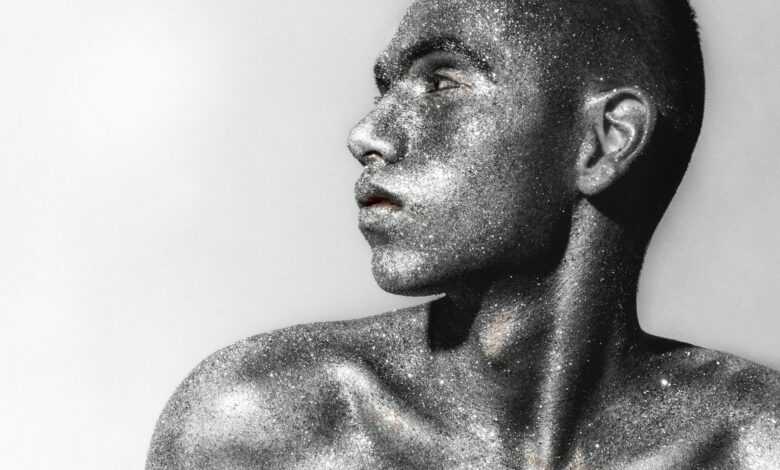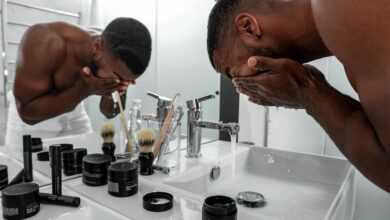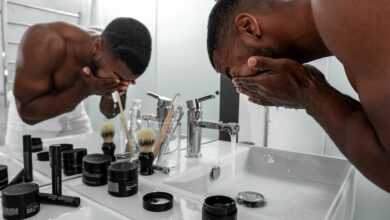
Night vs. Day Skincare: A Bloke’s Guide to What’s Actually Different
You’ve probably seen them lurking in your partner’s side of the bathroom cabinet: a dizzying array of pots and potions, some labelled “day,” others “night.” For the average bloke, whose entire routine might consist of a splash of water and a single, all-purpose moisturiser (if that!), it can all seem a bit much. Do you really need a different cream for when you’re asleep? Is it all just a clever marketing ploy to get you to spend more money?
While the skincare industry certainly loves to sell us things, there is a genuine, logical reason for having separate day and night products. It’s not about fuss; it’s about function. Think of your skin as a busy city. During the day, it’s rush hour, with defenses up and barriers in place. At night, the city shuts down for maintenance, and the repair crews get to work. Your skincare should follow the same logic. Let’s break down the no-nonsense difference.
The Core Difference: Protect vs. Repair
If you take only one thing away from this article, let it be this:
- Daytime Skincare is for PROTECTION. Its main job is to act as a shield, defending your skin from the daily onslaught of environmental aggressors.
- Night-time Skincare is for REPAIR. Its main job is to support your skin’s natural regeneration process, replenishing moisture and tackling underlying issues while you sleep.
That’s it. One is your bodyguard; the other is your overnight repair crew. They have different jobs, so they need different tools.
Your Daytime Mission: The Shield (Protect & Hydrate)
From the moment you step out the door, your skin is under attack. The key aggressors in the UK are:
- UV Rays: The number one cause of premature ageing (wrinkles, sunspots) and skin cancer. This is a threat even on the cloudy, grey days we’re famous for.
- Pollution: City grime and environmental pollutants can cause damage and dullness.
- Dehydration: Wind, central heating, and air conditioning all sap moisture from your skin.
Therefore, a good daytime moisturiser is designed to fight these battles.
What to look for in a Day Cream:
- SPF (Sun Protection Factor): THIS IS NON-NEGOTIABLE. If your day cream doesn’t have at least SPF 30, you’re missing the most important protective step. It’s the best anti-ageing product you can buy, full stop.
- Antioxidants: Ingredients like Vitamin C or Vitamin E act like bodyguards, helping to neutralise damage from pollution. You don’t need to obsess over this, but it’s a great bonus.
- Lighter Texture: Day creams are typically formulated to be lightweight, absorb quickly, and not leave you looking greasy. They should sit well under your (metaphorical) daily armour.
Your Night-time Mission: The Repair Crew (Replenish & Regenerate)
Night is when your body does its best work. Your skin’s cell regeneration process kicks into high gear while you sleep. Blood flow to the skin increases, and it works to repair the damage from the day. A night cream is formulated to support and enhance this natural process.
What to look for in a Night Cream:
- Richer Texture: Night creams are often thicker and more emollient. You don’t have to worry about looking a bit shiny when you’re going to bed, so they can pack in more heavy-duty moisturisers.
- Active “Repair” Ingredients: This is where the magic happens. Night is the perfect time to use powerful ingredients that can make skin more sensitive to the sun.
- Retinoids (like Retinol): The gold standard in anti-ageing. It helps to speed up cell turnover, boost collagen production, and improve skin texture. It’s a night-only ingredient because it breaks down in sunlight and makes your skin more sun-sensitive.
- Exfoliating Acids (like Glycolic Acid): These gently dissolve dead skin cells while you sleep, revealing brighter, smoother skin in the morning. Again, these can increase sun sensitivity, making them ideal for night use.
- No SPF: Your skin doesn’t need sun protection while you’re asleep. Putting SPF on at night is pointless and can sometimes clog pores.
The Pragmatic Bloke’s Verdict: Do I *Really* Need Both?
Okay, let’s get down to brass tacks. What’s actually necessary?
Level 1: The Absolute Bare Minimum
If you are only going to use ONE product, for the love of all that is holy, make it a daytime moisturiser with SPF 30. Protecting your skin from sun damage is far more important than any fancy repair cream. You can use this in the evening too, but you’re wasting the SPF.
Level 2: The Sensible, Effective Upgrade (Recommended for most guys)
Yes, you should aim to have two different products. But it doesn’t have to be complicated.
- Morning: A good moisturiser with SPF 30.
- Evening: A simple, hydrating night cream. It doesn’t need to have all the fancy active ingredients. Just a solid, no-frills moisturiser (like a CeraVe or La Roche-Posay cream) to replenish moisture overnight. This is the sweet spot for most men.
Level 3: The “I’m Getting Serious About This” Approach
This is for when you want to actively target ageing or skin texture.
- Morning: SPF 30 Moisturiser.
- Evening: A night cream or serum that contains a “repair” ingredient like Retinol. Start with a low concentration and use it only a few times a week to let your skin get used to it.
A Quick Word on Eye Cream…
Is it just a tiny pot of expensive moisturiser? Sort of. The skin around your eyes is thinner and more delicate, so eye creams are formulated to be less irritating. For a beginner, gently tapping your regular night cream around the eye area is fine. If you have specific concerns like dark circles, a dedicated eye cream might be worth considering later on.
So, is day and night skincare a con? No. It’s based on the simple, logical idea that your skin needs different things at different times. It needs a shield for the day and a repair crew for the night.
You don’t need a ten-step routine, but upgrading from one all-purpose cream to a simple Day (SPF) and Night (Hydrating) duo is one of the most effective, no-nonsense things you can do for your skin. Sleep on it, chap.




